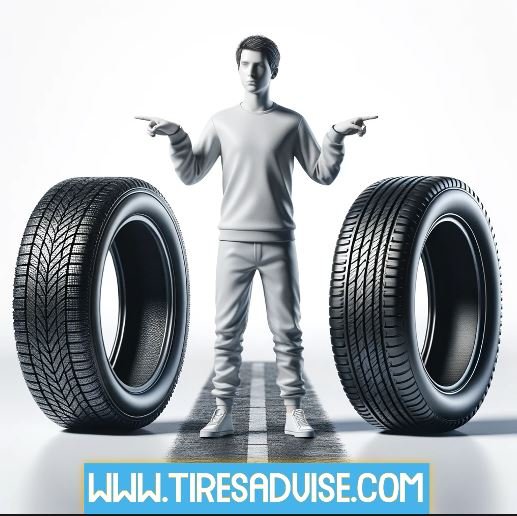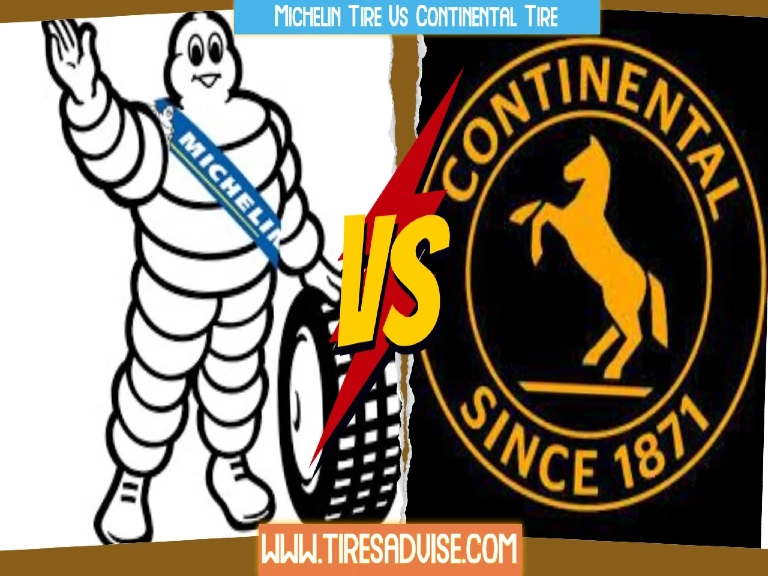Tires are crucial in the fast-paced world of automobiles. But with so many brands vying for attention, how does one choose between the giants like Michelin and Continental?
Michelin tires are normally more expensive but perform slightly better on dry roads, whilst Continental tires provide more models and are less expensive. So, which one’s the better fit for your vehicle?
Why do some drivers swear by the luxury of Michelin, while others lean towards the affordability of Continental? It’s akin to choosing between a gourmet meal and a hearty buffet. Both have their merits, right?
The essence of this article dives deep into this debate, unraveling the intricacies of each brand. Curious about wet road performance? Or perhaps the longevity of the tire? We’ll tackle it all.
By the end, you’ll be equipped with the knowledge to make an informed decision. Ready to embark on this rubbery journey? Let’s roll!
Historical Background of Michelin And Continental Tire
The world of tires has a fascinating tale that stretches back to the late 1800s. John Boyd Dunlop created the first air-filled tire in 1888, not for a car, but for a tricycle. From that humble beginning, the tire world expanded, with many brands racing to leave their mark. Among these, Michelin and Continental stand tall as two giants.
Michelin’s Journey: From Removable Bicycle Tires to Global Dominance
The Humble Start
In the heart of France, in 1889, two brothers, André and Édouard Michelin, embarked on a mission. They introduced removable bicycle tires, a game-changer compared to the solid rubber tires of that era. It’s like swapping out a pair of uncomfortable shoes for a comfy pair of sneakers.
The Rise to Fame
By 1895, Michelin took a bold step into the automobile world, crafting its first car tire. Fast forward to 1925, and they were the kings of the European tire market. Their secret? Constant innovation. In 1946, they introduced the world to radial tires, a move that reshaped the tire landscape.
Today’s Footprint
Michelin’s reach now spans over 170 countries. They’re not just a brand; they’re a household name, synonymous with quality and innovation.
Continental’s Evolution: From Rubber Goods to Racing Circuits
The German Genesis
1871 marked the birth of Continental in Hanover, Germany. Initially, they dabbled in rubber goods, but by 1892, they ventured into bicycle tires and soon after, in 1898, car tires. It’s like a local bakery expanding its menu from just bread to pastries and cakes.
The Race for Excellence
The 1930s saw Continental zoom into the world of motorsports. Their tires graced racing circuits globally, earning them a reputation for speed and reliability. And they didn’t stop there. The 1950s brought another feather in their cap with the introduction of the first tubeless tire.
Global Footprints
Today, Continental’s presence is felt in over 60 countries. They’ve become a trusted name, offering a plethora of tire choices for various needs.
Market Magnitude
In the grand arena of tire sales in 2022, Michelin wore the crown with a staggering $25 billion in revenue, while Continental proudly stood fourth, raking in over $12 billion.
It’s like comparing two popular restaurants; one might have more outlets, but both serve dishes that have their own loyal fan base.
Both these tire giants have their footprints from the chilly terrains of North America to the warm roads of Africa, showcasing their global dominance.

Performance Across Different Segments of Michelin and Continental Tires
In the vast universe of tires, performance is paramount. Different tires cater to different needs, and understanding these can be like choosing the right shoes for the right occasion. Let’s dive deep into the world of Michelin and Continental across various segments to see how they stack up.
1. Ultra Ultra High Performance (UUHP) Showdown
When it comes to the crème de la crème of performance, the Michelin Pilot Sport 4S and the Continental SportContact 6 are like two-star athletes. The Pilot Sport 4S shines with its impeccable grip on both wet and dry roads, ensuring a ride that’s both smooth and safe.
On the other side, the SportContact 6 by Continental promises a ride that’s not just precise but also whisper-quiet. It’s a close match, like comparing two top-notch chefs. While the Pilot Sport 4S might have an edge on dry roads, the SportContact 6 takes the lead when the roads get wet.
2. Ultra High Performance (UHP) Face-off
Stepping into the realm of UHP, the Michelin Pilot Sport 4 and the Continental ExtremeContact Sport are the big players. It’s like choosing between a luxury sedan and a sports car. Both offer a blend of wet and dry grip that’s hard to beat.
The Pilot Sport 4 promises a ride that’s as comfortable as sitting in a plush armchair, while the ExtremeContact Sport by Continental ensures that even on wet roads, the car stays glued to the ground.
3. Touring Tires: Comfort Meets Longevity
For those long drives where comfort is key, touring tires come into play. The Michelin Primacy Tour A/S is like that reliable friend who’s always there, offering a silent, comfortable ride and a tread that seems to last forever.
In contrast, the Continental PureContact LS is like a marathon runner, ensuring grip whether the road is wet or dry.
4. Eco Tires: The Green Revolution
In a world where being green is gold, eco tires are the future. The Michelin Energy Saver A/S is like a hybrid car, focusing on fuel efficiency without compromising on life. It’s all about going the extra mile with less.
The Continental EcoContact 6, on the other hand, ensures that whether it’s raining or shining, the grip remains uncompromised, all while saving on fuel.
5. All-Season Versatility: Rain, Shine, or Snow
The Michelin CrossClimate2 is that all-rounder, ensuring grip whether you’re driving under the summer sun or winter snow.
The Continental ExtremeContact DWS06, however, promises a grip that’s slightly superior when the roads get wet, making it a tough competitor.
6. Winter Warriors: Conquering the Cold
Winter demands a special kind of tire, one that can brave the cold and conquer the ice. The Michelin X-Ice Snow is like a snow leopard, ensuring traction even in the iciest conditions.
The Continental WinterContact SI, however, promises a ride that’s not just smooth but also silent, making those winter drives a tad more comfortable.
7. Nordic Navigators: Dominance in Ice and Snow
In the harshest of winter conditions, Nordic tires come to the rescue. The Michelin X-Ice North 4 ensures that whether it’s snow or ice, the car remains in control. It’s like having ice skates that never slip.
The Continental IceContact 3, however, takes the cake when it comes to comfort, ensuring that even in the coldest conditions, the ride remains quiet and smooth.
Technological Innovations of Michelin And Continental
In the dynamic world of tires, innovation is the driving force. It’s like the secret sauce in a chef’s recipe, making all the difference.
Both Michelin and Continental have been stirring this sauce for over a century, bringing groundbreaking technologies to the table.
Michelin’s Pioneering Technologies
Michelin, with its rich legacy, has always been a beacon of innovation. There are over 6,000 experts in 350 fields bustling around the Michelin Technology Center, a massive technology hub.
It’s like a grand symphony of researchers, engineers, and testers, all working in harmony. Their collective genius has led to the filing of over 10,200 patents globally, a testament to Michelin’s relentless pursuit of the next big thing.
One of Michelin’s crowning achievements was the introduction of the radial tire in 1946. To understand its significance, think of it as the smartphone in the world of communication. It was a game-changer.
Fast forward to 2004, and Michelin unveiled the Ultraflex technology. For farmers, this was a boon.
Their recent marvel, the MICHELIN CrossClimate2, is like an all-terrain boot. Whether it’s a rainy day or a snowy evening, this tire ensures the car remains steady and safe.
Continental’s Cutting-Edge Advancements
Continental, another stalwart in the tire industry, has its own tale of technological wonders. With a global team of over 50,000, including the brightest researchers and engineers, Continental is like a vast ocean of ideas. This ocean has given birth to over 24,000 patents, each one a ripple of innovation.
The 1950s saw Continental make a splash with the introduction of the first tubeless tire. It’s akin to inventing the zipper for clothing, making things simpler and more efficient. Another feather in their cap is the ContiSeal technology.
As you drive, you suddenly experience a punctured tire caused by a nail. But instead of deflating, the tire seals itself, allowing you to continue your journey. It’s like having a self-healing wound.
Their latest gem, the Continental ExtremeContact DWS06 Plus, is a testament to their commitment to excellence. It’s like having an all-weather jacket, ensuring grip and safety, come rain or shine.

Price, Warranty, and Value Proposition
Choosing the right tire involves considering its cost, the assurance it provides, and the overall value it offers. Let’s quickly compare Michelin and Continental on these fronts.
1. Investing in Premium: Michelin’s Price Range
Michelin is the luxury segment of tires. Their prices range from $100 to $500, reflecting their commitment to quality and innovation. Premium models like the Michelin Pilot Sport 4S can cost between $200 to $500, attributed to their advanced features and technology.
2. Balancing Performance and Affordability: Continental’s Offerings
Continental offers a blend of performance and affordability. Their tires are priced between $70 and $300. Even their high-end models, such as the Continental ExtremeContact Sport, are reasonably priced between $100 to $300, making them a favorite for those seeking value.
3. Warranty Wars: Promise Plans and Confidence Plans
Michelin offers the Michelin Promise Plan, which includes a 60-day satisfaction guarantee, limited and treadwear warranties, and added benefits like roadside assistance.
Continental counters with its Absolute Confidence Plan. It provides a 60-day trial period, a limited warranty, a treadwear warranty, and a unique road hazard warranty.
Tabular Comparison Between Michelin and Continental Tires
| Sr. No | Criteria | Michelin Tire | Continental Tire |
| 01 | Price Range | $100 to $500 | $70 to $300 |
| 02 | Premium Tire Price Range | $200 to $500 (e.g., Michelin Pilot Sport 4S) | $100 to $300 (e.g., Continental ExtremeContact Sport) |
| 03 | Technological Focus | Innovation and development of new technologies | Balancing performance with affordability |
| 04 | Warranty Offered | Michelin Promise Plan | Continental Absolute Confidence Plan |
| 05 | Warranty Features | 60-day satisfaction guarantee, limited warranty, treadwear warranty, roadside assistance | 60-day trial, limited warranty, treadwear warranty, road hazard warranty |
| 06 | Notable Technological Innovations | Radial tire (1946), MICHELIN Ultraflex technology (2004) | First tubeless tire (1950s), ContiSeal technology |
| 07 | Recent Innovations | MICHELIN CrossClimate2 | Continental ExtremeContact DWS06 Plus |
FAQs
Do Michelin and Continental tires come with run-flat technology?
Both brands offer specific tire models with run-flat technology, allowing drivers to continue driving for a limited distance after a puncture.
How often should I replace Michelin or Continental tires?
The replacement frequency depends on usage, driving conditions, and tire wear. It’s recommended to regularly check tire tread depth and consult with a tire specialist.
Conclusion
In the tire industry, the journey of innovation and technological advancements is as crucial as the product itself. While Michelin and Continental both have deep-rooted histories and have contributed immensely to the evolution of tires, their approaches differ.
Michelin leans towards premium offerings, emphasizing cutting-edge innovations, whereas Continental focuses on balancing performance with affordability. Both brands have their unique value propositions, catering to different segments of the market.
In essence, Michelin tires tend to be pricier but excel slightly on dry roads, while Continental offers a broader range and is more budget-friendly. Choosing between them boils down to individual preferences and priorities, ensuring that drivers have options that cater to their specific needs.

